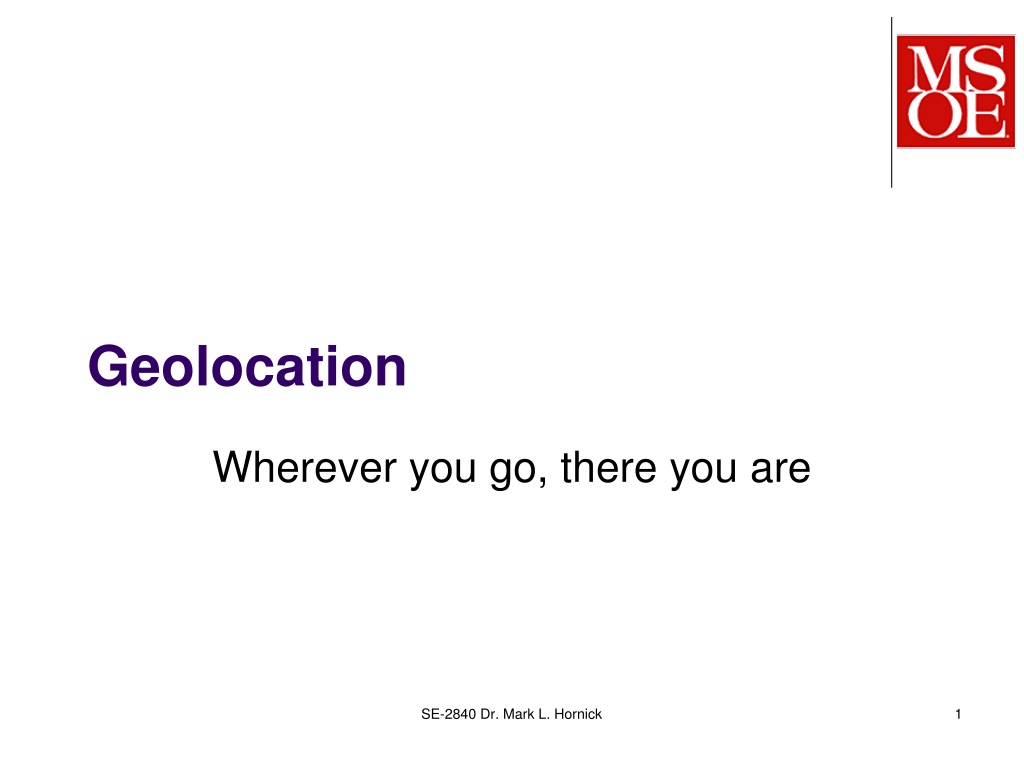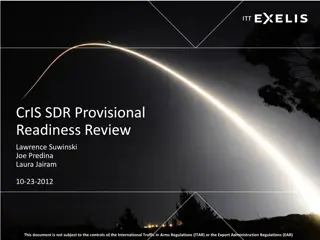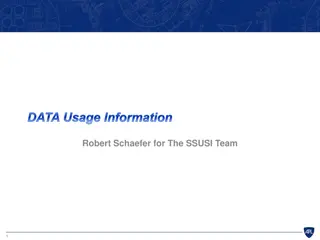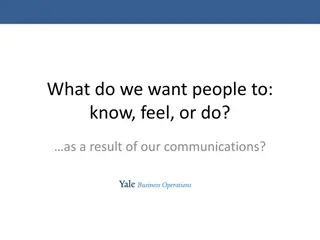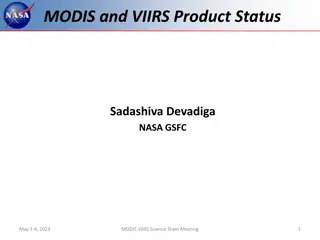Understanding Geolocation: What You Need to Know
Geolocation is a built-in browser functionality that allows web applications to be location-aware. It uses geographic latitude/longitude and is supported by all modern browsers, making it an integral part of the HTML5/W3C JavaScript API. With geolocation, you can show users their position on a map, provide directions to points of interest, alert users to nearby places of interest, and more. The browser obtains user consent before using their location data and can determine location through IP addresses, wifi networks, or cell towers. Learn how geolocation enhances user experiences and enables various features on the web.
Download Presentation

Please find below an Image/Link to download the presentation.
The content on the website is provided AS IS for your information and personal use only. It may not be sold, licensed, or shared on other websites without obtaining consent from the author. Download presentation by click this link. If you encounter any issues during the download, it is possible that the publisher has removed the file from their server.
E N D
Presentation Transcript
Geolocation Wherever you go, there you are SE-2840 Dr. Mark L. Hornick 1
What is Geolocation? Built-in browser functionality that lets you make a web application location-aware Geographic latitude/longitude Supported by all modern browsers Geolocation services are part of the HTML5/W3C JavaScript API SE-2840 Dr. Mark L. Hornick 2
What can you do with Geolocation? Show user s position on a map Indicate proximity to hospitals, coffee shops, public transit Provide directions to a known point of interest Alert users to friends in the area Notify users of events, traffic, local weather Provide auto-assist for zip code, area code, shipping costs SE-2840 Dr. Mark L. Hornick 3
How does the browser know your location? First, the browser must obtain your consent to use your location This security mechanism is built-in and cannot be disabled (part of HTML5 specification) Next, the browser gathers information from your computer Collected info is sent to the default location service provider (Google Location Services) to get an estimate of your location SE-2840 Dr. Mark L. Hornick 4
Location on stationary desktop computers Location information generally available to the browser is limited to the IP address supplied by your ISP Universally available on any computer Often resolves to your ISP s office location, so accurate only to a neighborhood or city Limits what you can do with the information Local weather forecast Default language to present to user SE-2840 Dr. Mark L. Hornick 5
Wifi-based geolocation Google (and others) have an extensive database of wifi networks that were collected as part of the Google Maps project If multiple wifi hotspots are available, triangulation based on signal strength can be used to determine location to ~100 ft Relies on accuracy of the database SE-2840 Dr. Mark L. Hornick 6
Cellphone-based geolocation Cell towers report their geographical location to the device using the tower When multiple cell towers are available, triangulation based on signal strength can be used to determine location Fairly accurate (~100ft) Works indoors and outdoors In (rural) areas with few cell towers, accuracy is poor SE-2840 Dr. Mark L. Hornick 7
GPS-based geolocation Device hosting the browser contains hardware that receives signals from multiple GPS satellites in geosynchronous orbit Can be highly accurate (~3ft) Available everywhere Works outdoors only view of sky required Accuracy decreases in areas with tall buildings, forests, cloudy skies, sunspot activity SE-2840 Dr. Mark L. Hornick 8
How do you select which method your browser will use? You don t the browser will decide internally how it is going to determine your location. However, you can specify how accurate you want the answer to be The browser may communicate with your device to prompt you to enable GPS (if you have it) to get you a more accurate estimate of your location. SE-2840 Dr. Mark L. Hornick 9
BOM implementation: Geolocation services are part of the navigator child object of the window object The geolocation API methods are implemented in the navigator object. geolocation If geolocation is not supported, the navigator object will not have a geolocation child object. SE-2840 10 Dr. Mark L. Hornick
Geolocation JavaScript API: getting your location One-time position request: if( navigator.geolocation ) {// check for geolocation support navigator.geolocation.getCurrentPosition( displayLoc ); } else { // no geolocation object in BOM navigator alert( No geolocation support! ); } ... // This function is called when the location is found function displayLoc( position ) { var lat = position.coords.latitude; var long = position.coords.longitude; // TODO: display the position somewhere on the page } SE-2840 Dr. Mark L. Hornick 12
getCurrentPosition() details handling errors getCurrentPosition takes 1, 2, or 3 arguments: getCurrentPosition( successHandler, /* optional */ errorHandler, /* optional */ positionOptions); // This function is called when an error occurs: function errorHandler( error ) { // error.code is a value from 0 3: // 0: unknown error // 1: Permission denied by user // 2: position not available // 3: request timed out // if the error code is 0 or 2, error.message may // contain a more specific reason for the failure } SE-2840 13 Dr. Mark L. Hornick
Geolocation JavaScript API watching your location change Periodic update position request: if( navigator.geolocation ) {// check for geolocation support wID = navigator.geolocation.watchPosition( displayLoc ); } else { // no geolocation object in BOM navigator alert( No geolocation support! ); } // Call this function to cancel the watch function stopWatch() { if( wID ) { // make sure wID is not null navigator.geolocation.clearWatch( wID ); wID = null; } } SE-2840 Dr. Mark L. Hornick 14
positionOptions details changing how often your location is updated Both getCurrentPosition and watchPosition take an optional 3rdPositionOptions argument. getCurrentPosition( successHandler, /* optional */ errorHandler, /* optional */ positionOptions); // The positionOptions argument is a map: var positionOptions { enableHighAccuracy: true, // favor accuracy over speed timeout: Infinity, // ms to wait for pos value maximumAge: 0 // ms age of cached pos; 0=get new pos } SE-2840 15 Dr. Mark L. Hornick
